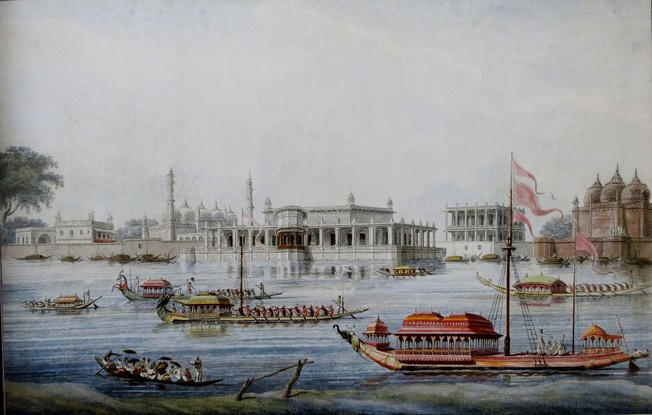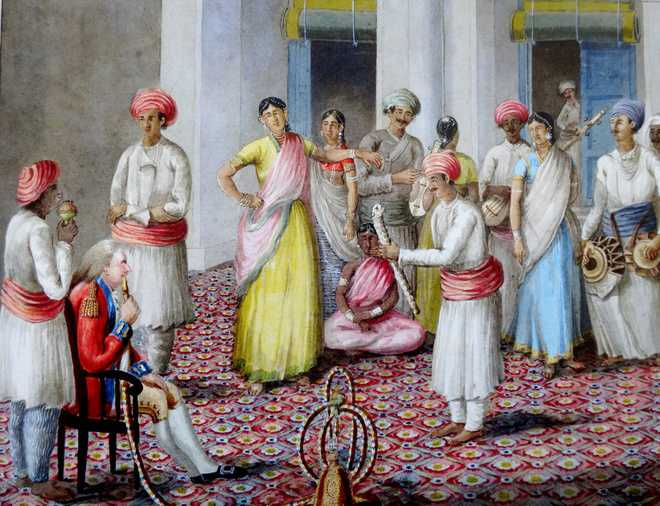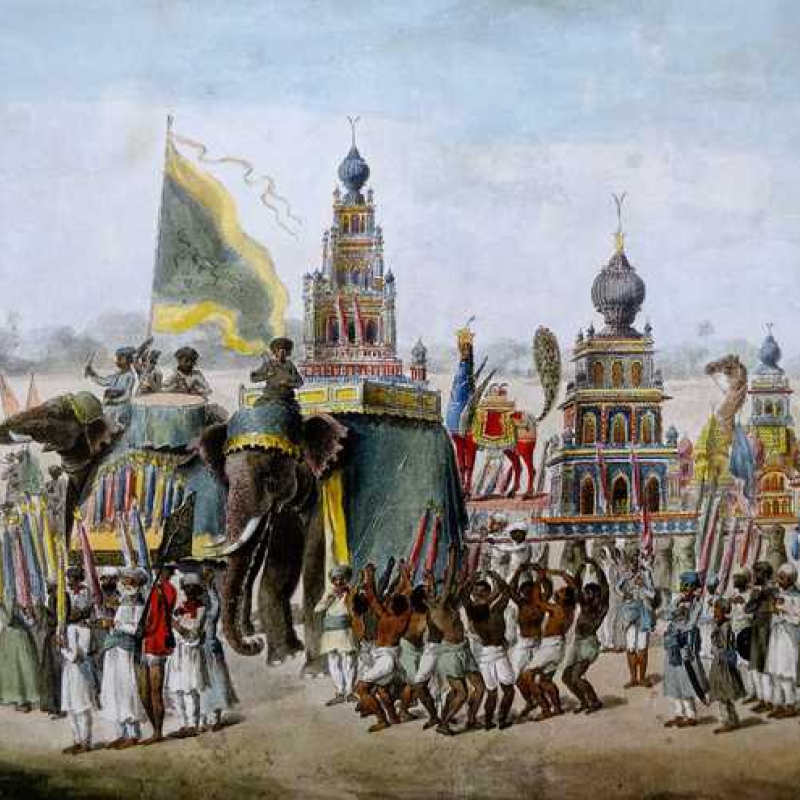In the 18th century, it was fairly common for officers of the East India Company and their families to record the landscape, architecture, people, customs, beliefs, festivals, flora and fauna of India. The famous Louisa Parlby album, named after the British lady who put such a collection together, takes one back to this 'Company School of Painting'. (In Pic: A tazia procession in Murshidabad; Photo Courtesy: The Tribune)
This article appeared originally in The Tribune, Chandigarh under the headline 'An Album from Murshidabad', and is reproduced here with permission.
Louisa (Parlby) may have been an early member of the ‘fishing fleet’, the rather unkind term for single ladies who sailed to India (from England) in search of a husband. (Ladies who didn’t manage to find one during the first season ashore were even more unkindly referred to as ‘returned empties’ when they went home.)— Rosie Llewellyn-Jones
From time to time, we keep being reminded about how important a centre of painting, Murshidabad—capital of the Nawabs of Bengal—was, at least in the 18th century. Currently, there is so much talk in art circles about a newly discovered album of watercolours, which can be traced back to that state and bears the name the Louisa Parlby Album, after the English lady who kept putting it together at the end of the 18th century when she and her husband, along with a whole drove of friends of theirs—all connected with the East India Company—were there in Calcutta, or nearby Berhampur. Louisa’s husband, James Parlby, had been in India from 1780 or so onwards, first as a cadet in the East India Company’s army, and then in other positions, rising slowly to occupy the rank of a Colonel. However, it was not as a soldier that he was to make a name, but as an engineer, building new roads, planning embankments, constructing residences, and generally taking charge of ‘palace buildings’ in the old Nawabi capital. It was in 1795 that he met and married Louisa of the Munt family. Louisa, now Louisa Parlby, stayed in these parts till ca. 1803—she left with her children for England then—and it is during this time, between 1795 and 1803, that she must have been assembling the paintings, all made by local artists, from Murshidabad and Patna, which now form part of this much talked-about album. That is the best information that one has.

There is obvious interest in these paintings—of the ‘Company School’ as one might call them, following general usage—not only on account of their own quality but also because they form a record of a distinct period when unexpected things were happening both in the politics and the arts of our land. The British had taken over parts of the country, and their power was seeping, with clear intent, into increasingly large regions. A large number of officers of the East India Company—all wide-eyed with wonder, and in part with amusement, in the new land in which they found themselves serving, or over which they were beginning to rule—were clearly interested in keeping a record of all that surrounded them in this new setting: landscape, architecture, people, customs, beliefs, festivals, flora, fauna. Some officers, with talents of their own, made these records themselves—sketching, painting, as they moved around; some others commissioned local painters to do it for them. It had, in fact, become fashionable to commission or collect paintings by local artists, mount them into albums, or store them in portfolios. The wealthier among the officers could afford to acquire oil paintings by distinguished European artists touring India, but those with more modest means, along with their ladies, collected or commissioned ‘Indian watercolours’. What they got were, as Rosie Llewellyn-Jones, says, 'skillfully executed, pleasing to look at during a rainy afternoon, or after a convivial supper'. What is more, these watercolours, gathered in albums, were easily portable, capable of accompanying their owners when they were ordered to different parts of India. And, of course, if the officer or his lady 'lived long enough to return home to Britain, the album went with them too, to be shown off as a rather splendid souvenir of the ‘when I was out in India’ kind.' The Louisa Parlby album gets precisely placed in this cultural context.

A large number of the paintings in this album feature houses, sprawling bungalows, which, it seems, belonged to the circle of friends and colleagues with whom the Parlbys must have formed some kind of a club. The men for whom these houses were built, would probably 'have all been neighbours, ranging in status from a baronet to the grandson of a stone mason, but who would nonetheless have visited each other’s houses, borrowed each other’s horses, and attended dinners and balls together'. The bungalows we see here are all ‘set in the lush Bengal scenery’ reminiscent in some manner of the English ‘gentleman’s seat’ back home. 'Cattle drowse on the lawns while their owners drowse too on their day beds, their stays and waistcoats loosened and the venetians closed'. These houses apart there are topographical views, some of them, like the one with state boats on the Bhagirathi river, or a view of the hills at Chittagong, exceedingly well painted. And then of course in the album are views of entertainments and festivals: an ageing, somewhat bleary-eyed Englishman, smoking a huqqa, and watching with almost excessive eagerness a ‘nautch’—complete with dancers and musicians and attendants—in the courtyard of his bungalow; a tazia procession with countless people marching along elephants and carriers supporting architectural replicas of sacred buildings; a group of Vaishnavites dancing and singing with gay abandon in a kirtan-mandali.
There is much to see and relish in these unpretentious but deeply engaging ‘Murshidabad’ watercolours. What one notices with regret, however, is the fact that there is not a word about who the painters might have been; there are no signatures, no attributions. A sea of anonymity, yet again!
This article has been republished as part of an ongoing series Art N Soul from The Tribune.












